Who can identify the kit in this clip?
Who can identify the kit in this clip?
Kellogg, ID – Grey Ghost Gear has been working intently on a new plate carrier system for over 2 years, and after countless hours of designing, sewing, field testing, redesigning and retesting downrange by legitimate U.S. warfighters, it’s finally making its debut to the rest of the world. So, buckle up, because there’s a lot to cover here! Meet the Grey Ghost Gear SMC Plate Carrier and Back Panels.
As you may know, the Minimalist Plate Carrier has been the one and only carrier offered by the PNW based nylon gear manufacturer. Just like the name implies, the Minimalist was designed as a no frills, one size fits all carrier that lacked extra bells and whistles like a cummerbund and side plate pockets, but hit a sub $140 price point that made it a favorite among firearm instructors, on and off duty officers, and even CrossFit weight trainers. Despite its obvious simplicity, many GGG fans have been clamoring for a more “jocked” up carrier that would accommodate more features that professional users demand.
The SMC Plate Carrier (Shoot, Move, Communicate) is Grey Ghost Gear’s contender in the elite ring of carriers that only a small group of gear manufacturers compete in. Designed specifically for SOCOM and JSOC end users who are already accustomed to using modular zippered back panels, quick release systems and laser cut laminate designs, the SMC line of gear brings a whole new level of innovation to the company’s tactical product lineup. “It’s everything we’ve wanted in a lightweight, combat-ready plate carrier, and we’ve worked closely with some of our nation’s most radical individuals to design a carrier and supporting back panels that fit their needs right now, right as you are reading this sentence” says GGG SOCOM Special Projects Manager David Hannah.
“We’re an end-user focused company, and we’ve designed the whole SMC line specifically for warfighters and law enforcement professionals across the spectrum of operations. These elite units and individuals have special needs and requirements that can change at the very last minute even as you are on route to the mission. Imagine, you’re already on the bird with your team and the mission changes from Direct Action, to Hostage Rescue to SSE (Sensitive Site Exploitation), the ability to rapidly change your squad’s loadout is paramount. You don’t have time to unweave your pouches and reconfigure each squad member’s carrier. Rigging up secondary carriers for your whole team on the fly takes up too much valuable time and focus. That’s why most SOCOM units already utilize a modular system consisting of zippers that allow back panels to be rapidly swapped out in a matter of seconds.” Grey Ghost Gear has designed the SMC Carrier and SMC back panels to work with this already established footprint and expound on the different custom panels and packs that are desperately needed by these JSOC operators currently deployed.
The SMC panels that Grey Ghost Gear has designed almost outshine the carrier itself. For those who already have an issued carrier with zippers in the back, you’re in for a real treat. First off, the 1 to 3 Assault Pack. It is an expandable backpack that can not only scale from a 24 to 36-hour pack with its internal zippered gusset, but also has its own hidden shoulder straps for when you just want to roll in plain clothes. It has been tested for freefall operations, with no spider harness required. When the pack is expanded into the 3-day configuration, a dry bag closure keeps all your goodies inside dry.
Next, the SMC Assaulter Panel: three permanent yet adjustable double mag pouches and a built-in utility pouch, perfect for keeping your squad mates topped off with fresh mags, smoke and frags. The pouches have flaps that can adjust in length to perfectly envelope your mag of choice, no matter the size. There’s even an internal loop for securing grenades, because bending a spoon is a rough way to end the day. It will also hold one full MRE, a log of snuff and three 16oz cans of your favorite beverage.
For the DIY type, GGG also has released a MOLLE or Laser Cut Laminate back panel for you to customize yourself with those extra pouches you’ve got laying around the garage. To quote GGG’s website description: “It’s like a blank canvas, but for violence.” For those who don’t have zippers equipped on their existing carrier, Grey Ghost is also offering Zipper Adapters. Simply use the MALICE® Clips to attach the adaptors to your Minimalist or other carrier and WHAMO, you’re now ready to use the SMC back panels. Last but not least, every SMC Back Panel has an internal compartment that can open up to accommodate bolt cutters, charges, or a water bladder (anti-sag built in)
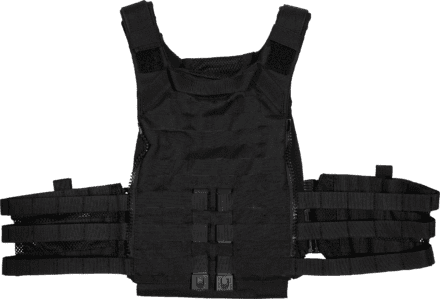
The SMC Carrier is adjustable for most warrior body types via the cummerbund interlocking system in the back as well as adjustable shoulder straps for torso height
Designed to carry a pair of 10×12 hard plates, thicker composite plates with a second change backer (soft armor) or large ESAPI plates, the SMC Plate Carrier features laser cut laminate, giving you all the modularity of traditional MOLLE webbing at a significant reduction in weight. Longevity is also increased as cut edges resist fraying after they are heat sealed with the laser. The included adjustable cummerbund features MOLLE/PALS style webbing for the addition of pouches for side plates if desired, and the front panel also features an open pocket for maps, water/cable retention or enough room for a fleece watch cap or gloves.
This carrier is “one size fits most” thanks to its adjustable shoulder straps and cummerbund, ensuring a snug fit for just about every warrior’s body type. Should you find yourself on fire, trapped in a tight spot or unexpectedly going for a swim, the ROC buckles on each shoulder strap and either side of the cummerbund can be rapidly released in case of emergency. These also make putting on the carrier much more convenient when you are in a hurry. The shoulder ROC buckles are easily removable if you prefer to use the metal common loop that is already attached.
The SMC Plate Carrier can be found now on GGG’s website with an MSRP of $302 for Black and Coyote Brown and $322 for MultiCam® with the first week of April being the estimated delivery. As for each of the back panels that are available now:
Looking for a back panel with a little more Chutzpah? Seen at SHOT Show 2020, Grey Ghost Gear and sister company Tactical Tailor collaborated on a back panel that holds 15 40mm grenade rounds. Available from Tactical Tailor, this back panel shares compatibility with the Grey Ghost Gear SMC line as well as many issued carriers with integrated zippers on the back.
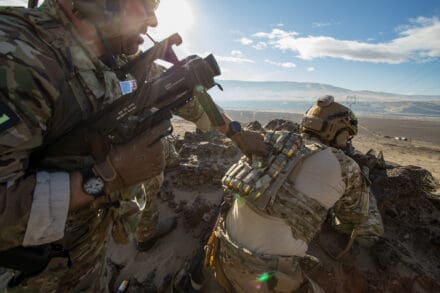
With the launch of the SMC Back Panels, Grey Ghost’s sister company Tactical Tailor helped produce 40mm grenade back panels for DOD customers by request
Visit http://www.greyghostgear.com for more details.
The new TBH-R1 from Gentex is a rifle rated helmet. It incorporates everything you love about Gentex helmets, Modular Bungee Shroud, Ops-Core ARC Rails and liner/suspension systems. It’s offered in High, Mid and Low cut in a variety of colors.
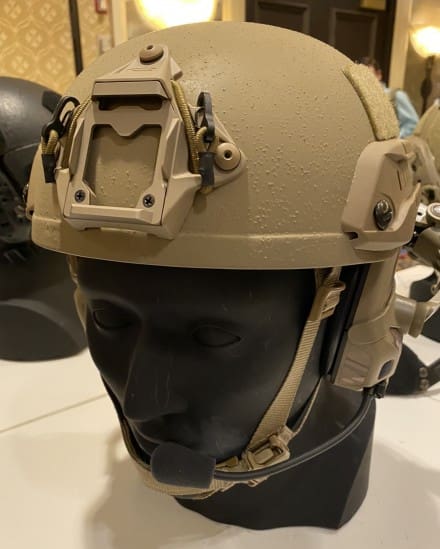
What the TBH-R1 also offers is ballistic protection against 7.62×51 M80 NATO Ball along with handgun protection from 9mm 124gr FMJ and others. Naturally, it also offers Frag protection you to 17gr with a V50 at 3,190 FPS.
Wallace, ID – Every year about this time you can expect to see something new drop from industry veteran Grey Ghost Precision, and 2020 is no exception! Looking back on 2019 we saw more aftermarket support for the GLOCK® platform including new slides for the G17, G19 and G26 as well as an added FDE color option for the Combat Pistol and CP frames. They also kicked open the door on the P320 market with their GGP320 slides for the SIG® P320/M17/M18 platforms that gave P320 users more options for slide serrations, finish/color and red dot mounting right out of the box. We can all agree that it’s been the golden age for custom pistol builders, and this year is no different!
So, what’s in store from GGP in Q1 2020? Starting with their SIG® aftermarket line, Grey Ghost Precision is giving P365 fans their very own GGP slides, as well as match-grade barrels! Two brand-new GGP365 slides have been unveiled, and they bring something big to the table in terms of options for P365 owners. Just like their bigger bros GGP320 slides, the GGP365 slides are available in Black or Grey DLC (diamond-like coating) finish, with a Flat Dark Earth Cerakote option to closer match the P365 models with FDE colored frames. The Version 1 slide boasts diagonal serrations that are deeper and more aggressive than OEM slide serrations, while the Version 2 slide has a bit more sophistication. The front and rear of the slide feature recessed areas with fine ribs of serrations that give you plenty of grip, and looks classy as hell. Both of these GGP365 slides come milled precisely for the Shield RMS-C and SIG RomeoZERO micro optics, with an attractive G10 cover plate that fills the footprint if you choose not to run an optic. The MSRP of both versions of the GGP365 slide are $418.95.
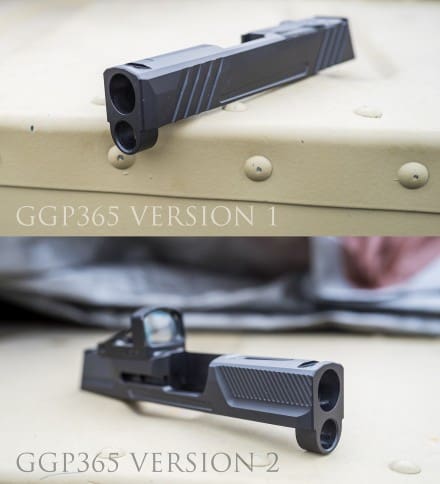
GGP is also releasing pistol barrels for the P365 as well as the P320 Compact and Full-Size models. Each of these barrels are black nitride coated and are SAAMI spec match-grade. Threaded P320 barrels feature ½ x 28” threads for those who want to use muzzle brakes, compensators or suppressors. Speaking of suppressors, Grey Ghost Precision specifically optimized their GGP320 barrels for improved function when suppressing P320 pistols. The MSRP of the GGP320 barrels are $184.99 for non-threaded barrels, $194.99 for threaded models.
GLOCK® fans are getting some love, as GGP is also releasing threaded and non-threaded G26 barrels, as well as Gen 5 barrels for G17 and G19 pistols. You read that right, Gen 5 barrels. As you may know, 5th generation GLOCK® slides feature quite a few changes that removed compatibility with several Gen 1-4 parts, including the slides themselves. These new GGP17/19 Gen 5 barrels are $179.99 for non-threaded barrels, $189.99 for threaded models (which also include an O-ring and a thread protector).
That leads us to the next GGP release for the new year… GGP-19 and GGP-17 Gen 5 slides! Finally, you will be able to upgrade your OEM Gen 5 pistol with a GGP aftermarket slide and take advantage of the accuracy-improving critical tolerances that Grey Ghost has tightened in all their slides. Additionally, these new Gen 5 slides also benefit from GGP’s hybrid optic compatibility with the Trijicon® RMR and Leupold® DeltaPoint Pro red dot optics using the supplied low-profile shim plates and specialty screws that come in every box. Two popular optic footprints, and all without the need for bulky adapter plates that would only raise the optic above the bore axis, and 4 different but equally functional serration patterns to choose from. The MSRP of GGP17/19 Gen 5 GLOCK® slides are $449.99 for Versions 1 and 3, and $418.95 for Versions 2 and 4.
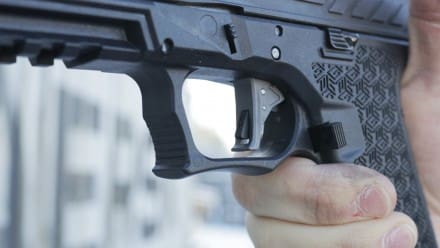
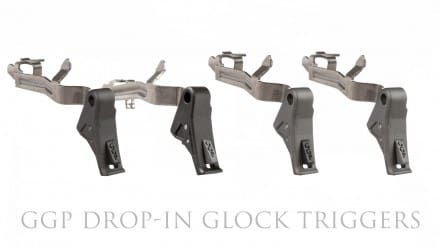
In the immortal words of Billy Mays: “BUT WAIT, THERE’S MORE!” Grey Ghost Precision has one more bomb to drop. They have developed their own signature aftermarket trigger for GLOCK® pistols. This drop-in trigger, which GGP calls the Combat Trigger, has a flat faced shoe with a minimal toe. “We designed this trigger from the ground up” said GGP Head Engineer Jason Fancher. “Using 3D software, we were able to rapid prototype several shoe designs using 3D printing technology. After experimenting with different geometry, we arrived at a design that felt perfect to the shooter. The flat face is specifically designed to give the shooter a repeatable straight trigger pull every time, with the precise reset that we all as shooters prefer in our carry guns.” The GGP Combat Trigger includes an OEM trigger bar to retain the safe function in your GGP Combat Pistol or your GLOCK®, making it ideal for Concealed Carry, Military and Law Enforcement use. The MSRP of the GGP Combat Trigger is $99.99, and it is available in four anodize color combinations: all black, all grey, black trigger/grey/safety and grey trigger/black safety. All new GGP Combat Pistols come with the all black GGP Combat Trigger installed, with no change to its existing MRSP of $1,499.
Be sure to subscribe to the Grey Ghost Precision email list to be alerted as more new products become available.
Visit www.greyghostprecision.com for more details.

All these new products will be on hand at the Grey Ghost Precision booth (#4458) during the 2020 SHOT Show Expo in Las Vegas, NV, held January 21-24th.

We are looking forward to a very busy 2020! We hope yours is prosperous as well.
We recently published our 27,000th live post. Still chugging along, 11 years into it.

This is a 1968 painting by American cartoonist Karl Hubenthal depicting a Soldier in Vietnam opening a present from home. The Jack in the box is entertainer Bob Hope who made an annual visit to deployed troops as part of the USO.